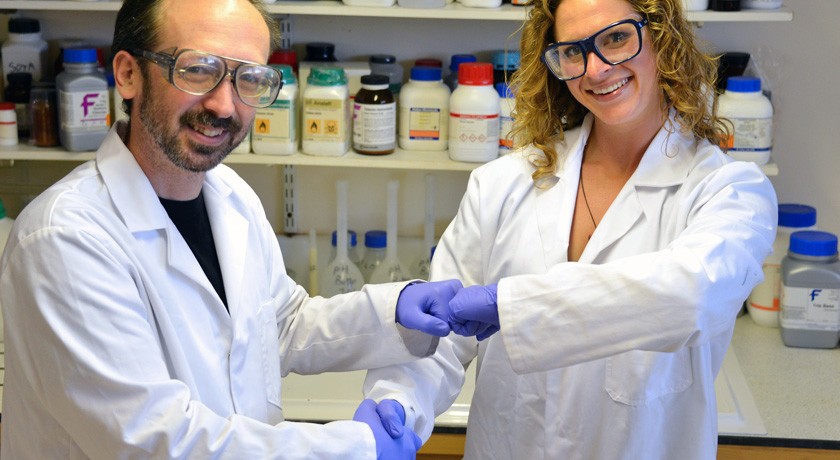Fist bumps cleaner than handshakes
A popular Obama greeting gets high marks for healthiness

David Whitworth and Sara Mela contrast two ways to meet and greet — the fist bump (above) and the less hygienic handshake (below).
Aberystwyth University
By Janet Raloff
A polite way for people to acknowledge meeting is to shake each other’s hand. Scientists have known that people can share germs this way. But what’s a better alternative? Consider the fist bump. It delivers only a small fraction of the germs transferred in a handshake, a new study shows. And the fist bump has become widely popular. President Obama fist bumps. So does the Dalai Lama.
The new findings fall into that “no, duh” category. After all, if a smaller area on the hand contacts another person, it makes sense that fewer germs will be transferred. But that’s not how science works. To confirm even such an expected finding, researchers must carefully compare one form of hand contact against another. And that’s what Sara Mela, a graduate student, and microbiologist David Whitworth did. Both work at Aberystwyth University in Ceredigion, Wales.
|
In this video, David Whitworth explains how his team tested the ability of various hand greetings to transfer germs. Aberystwyth University |
They started by dipping a gloved hand into a solution that contained a rich concentration of E. coli bacteria. Although some strains of this bacterium can make people sick, the Welsh group used a nontoxic strain. After the glove dried, a researcher wearing it shook hands, high-fived or fist-bumped another person. And yes, that other person also wore gloves. After each greeting, Mela and Whitworth counted how many E. coli had been transferred from the germy glove to the clean one.
A handshake transferred more than twice as many bacteria as high-fiving. But the more sanitary fist bump delivered only a tenth as many bacteria as the handshake. Also, a long, firm handshake transferred more germs than a brief, not-so firm grip. Mela and Whitworth share their findings in the August issue of the American Journal of Infection Control.
One simple explanation for these results: A fist bump or high five are likely to put far less skin (or in this instance, glove) in contact with another person. And a long, firm grip may force more germs from one hand into contact with the other hand, the scientists say.
Though the tests involved harmless bacteria, similar results would be expected for other disease-causing microbes, including viruses such as influenza, Whitworth and Mela note.
A handshake or other simple touch to mark a greeting is welcomed in so many cultures that people are unlikely to give it up. However, Mela and Whitworth argue, “for the sake of improving public health, we encourage further adoption of the fist bump as a simple, free and more hygienic alternative.”
Power Words
bacterium (plural bacteria) A single-celled organism forming one of the three domains of life.
E. coli (short for Escherichia coli) A bacterium that researchers often use to study genetics. Some types of this microbe cause disease, but many other forms of it do not.
fist bump A greeting between two people where each one clenches a hand and gently butts its knuckles against those of the other.
germ Any one-celled microorganism, such as a bacterium, fungal species or virus particle. Some cause disease. Others can promote the health of higher-order organisms, including birds and mammals. The health effects of most, however, remain unknown.
graduate student Someone working toward an advanced degree by taking classes and performing research. This work is done after the student has already graduated from college (usually with a four-year degree).
high five A greeting between two people where each one raises an opened hand up in front of themselves and briefly bounces their palm off the others’ hand.
hygiene Behaviors and practices that help to maintain health.
infection A disease that can spread from one organism to another.
microbe Short for microorganism.
microorganism An organism that cannot be seen without aid of a microscope.
sanitize The process of removing substances that can spread disease.
virus Tiny infectious agents consisting of RNA or DNA surrounded by protein. Viruses can reproduce only by injecting their genetic material into a host cell.







